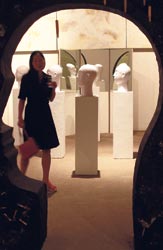The spacious warehouses behind Park Street Mews down Union Place once were stables. Last week they transformed into rambling art pavilions to accommodate an exhibition of contemporary art, the main event of the inaugural Colombo Art Biennale (CAB).
CAB, the brainchild of Annoushka Hempel, a British resident of Sri Lanka, was conceived in just five months; an achievement in itself in a culture that likes to take its time. CAB offered a broad creative experience, including not only contemporary visual art displayed in the warehouses, but a host of other programmes such as street theatre, art workshops, poetry and prose readings and talks, at venues across Colombo, all hinged on the theme “imagining peace”. A total of some 50 artists with CAB, and 20 independent satellite venues in association with CAB participated.
Despite the theme, images of discord were predominant in the warehouses. Exhibits focused on current post war issues; the IDPs, barbed wire, walls, corruption. One even featured the attack on the Twin Towers. Most artists seemed unable to break away from jarring current issues to focus singularly on peace, even if only imagined; a sign that the scars of conflict take time to heal.
Installation artist Chandragupta Thenuwera’s barrellism has progressed to a ‘wall-ism’. Walls are the metaphor to articulate his thoughts of imagining peace without forgetting past and present. Walls shield and protect, carry memories, seclude and hide. His white walls are not peaceful because they carry traces of discord.
In another pavilion, a set of giant drapes was used to make up a space within the exhibition hall. The fabric printed with white jasmine against black background with the flowers falling into outlines of domestic apparatus stimulated thoughts that peace for some may simply mean the freedom to get on with life. The black and white colours themselves brought polarity to mind; and the desire to put polarity in the past.
In contrast, a wall facing the pavilion displayed children’s art that portrayed imagined peace at its most innocent… communal harmony, religious tolerance, a beautiful touch and hope.
There were subjects other than the war. Harmonic shapes by Muhanned Cader at the Saskia Fernando gallery, and at the Barefoot pavilion, Druvinka’s large mixed media canvases sucked viewers into the numinous tantric inner world that must be traversed to find permanent peace.
A number of foreign artists participated, their presence adding to the richness of the experience. To mention two: Scotsman Ian Smith’s quirky installation of the country’s association with tea, and English artist Alex Stewart’s reflective art on everyday concerns of family, possessions and life in a conflicted environment.
CAB was more than an exhibition of art; it was an event, an exchange of creative energies, and a celebration. Hempel stated earlier that CAB is not only a showcase for Sri Lankan art, but a project with a vision. She hoped the show would prove that although Sri Lanka has been a politically, ethnically polarized society, artists still can work together in pursuit of harmony, a sign of peace in itself.
That Annoushka Hempel birthed CAB with a vision of unity and hope is also creditable, and healing. CAB sends the message that it is time to put communal and racial differences aside and work together constructively.
In drawing together diverse artists, venues and audiences, it certainly met that goal. It was also good to see the country’s creative talent given such a stimulating platform for expression. As the biennale progresses, it would be good to see more local artists, especially new talent, participate, as well as a move away from static statements to more dynamic interactive pieces. There is also a need to take into account the good that prevails in this country, and bring to light the little publicized inter-communal activities for a greater cause that exist parallel to discord.
As the sun set, crowds gathered, and small talk and laughter prevailed, telling us that the warehouses are a wonderful creative space to mix and mingle. Peace settled in with canapés from a vadai vendor from the neighbourhood and wine from Park Street Mews.
Someone commented that this is how the Galle Literary Festival was born. Today, it is a major event on the global literary calendar. CAB has the potential to put Sri Lanka on the international arts circuit.
|


